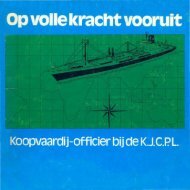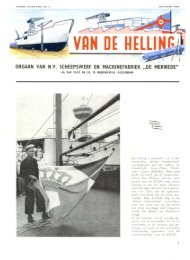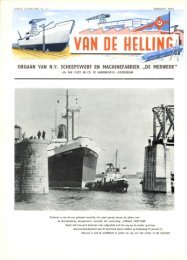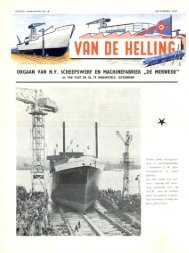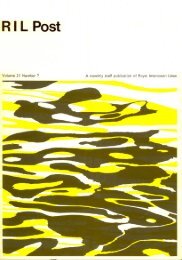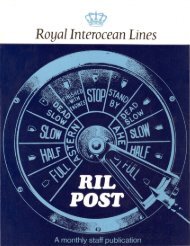Royal Interocean Lines - Varen Is Fijner
Royal Interocean Lines - Varen Is Fijner
Royal Interocean Lines - Varen Is Fijner
Create successful ePaper yourself
Turn your PDF publications into a flip-book with our unique Google optimized e-Paper software.
efficiency when towing and easier handling in the wheelhouse<br />
with visual control. Experience with variable pitch<br />
propellers has resulted in the installation of programmed<br />
cans for optimum combination of pitch and revolutions<br />
of the propellers for various conditions.<br />
A "push-button" system is also installed to facilitate<br />
maximum pitch of the propellers in a matter of a few<br />
seconds. During "crash-stop" t ri als it took less than 60<br />
seconds to make way over the stern after having gone<br />
full ahead at 13 knots.<br />
Automation is incorporated in many new vessels and,<br />
therefore, is used on the modern supplyboats to a very<br />
large extent. Notably, only the starting of the main<br />
engines and auxiliaries is done in the engine-room; all<br />
other controls a re in the wheelhouse where the emergency<br />
stops for main engines a nd cargo pumps are also situated.<br />
The Master, virtually performing a one-man show on the<br />
bridge, needs everything at his fingertips. The control<br />
panel in the wheelhouse features controls for the ancbr<br />
windlass, reversible pitch propellers, automatic steering<br />
and gyro compass, bow thruster and contains a transistorized<br />
Radar, Radio-telephone, VHF, Direction Finder,<br />
Echosounder, Decca, Loudhailer and a wide range of<br />
alarm and safety devices.<br />
The technique mainly used in the North Sea to tie up<br />
to the drilling rigs is to back up against the rig , nearly<br />
" When I saw the picture of Straat Mozambique and<br />
Houtman, tied up together in August's RIL Post, I<br />
remembered a similar photo which I am enclosing herewith.<br />
This photo was taken immediately after the launching of<br />
m.s. Houtman at Van der Ciessen's Yard in 1954. Please<br />
1954<br />
SUPPLY • BQ A TS (continued from prct••ous page)<br />
TO THE EDITOR<br />
206<br />
always making use of the bow anchors. It has been<br />
stated that the use of bow anchors on a supplyboat<br />
in one year exceeds the use of these anchors on an<br />
ocean-going freighter during her economic life, and for<br />
this reason the capacity and design of the windlass on<br />
supplyboats should leave absolutely nothing to be desired<br />
and should by far exceed Classification Rules.<br />
Special attention must be paid to the design and location<br />
of the bollards and capstans, particularly astern, in order<br />
to ensure a fast and safe mooring. for which heavy nylon<br />
ropes are often used. To be able to withstand the<br />
heaving of a supplyboat in rougher seas, the mooring<br />
system which has proved to be of good use consists of<br />
a heavy wire fastened onto a heavy nylon rope of 6-8"<br />
circumference, with a heavy ai rcraft tyre in between<br />
for elasticity. The crane boom on the rig should be<br />
sufficiently long to present the mooring ropes to the<br />
vessel without the latter having to manoeuvre too closely<br />
to the rig in rough seas. Polypropelene is also used<br />
because of its elasticity and floating characteristic, but<br />
is considered not as strong.<br />
It will be noted that the design, construction and operation<br />
of supplyboats is a difficult and complicated task.<br />
It is a relatively new industry in Dutch shipping and<br />
as such attracts a lot of attention. In spite of these<br />
complications everybody connected with the offshore<br />
exploration work finds it most interesting and rewarding.<br />
note that the position is the same: Mozambique's portside<br />
against Houtman's starboard."<br />
J. R. van Osse le n<br />
It is really an astonishing coincidence- and what a<br />
memory!<br />
1967



